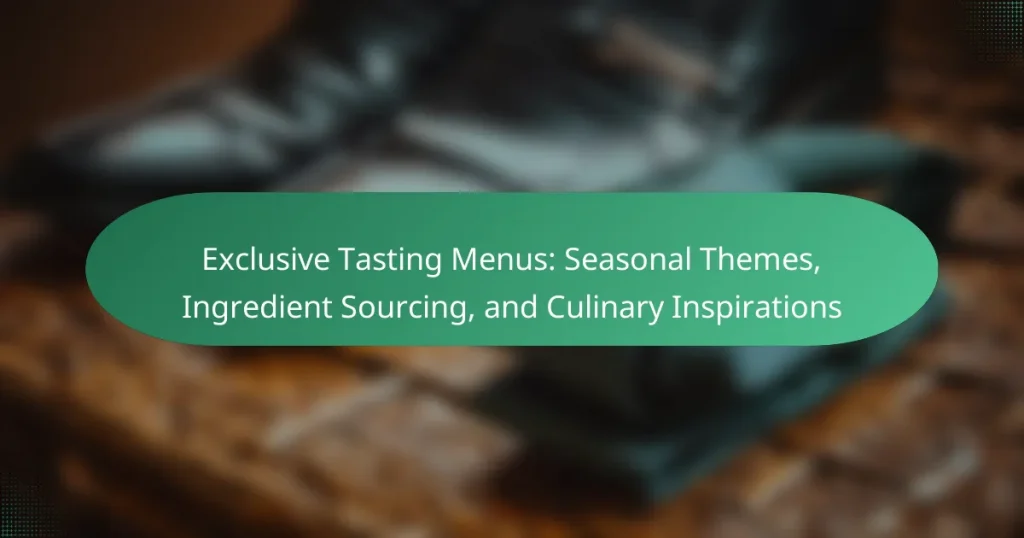Exclusive tasting menus are curated dining experiences featuring multiple courses that showcase a chef’s creativity and the restaurant’s culinary theme. These menus emphasize seasonal ingredients, unique flavor combinations, and often require advance reservations. Ingredient sourcing plays a crucial role in enhancing flavor, quality, and sustainability, with a focus on local and seasonal produce. The culinary inspirations for these menus draw from regional cuisines, cultural traditions, and personal experiences, resulting in a diverse and engaging dining journey. This article explores the significance of seasonal themes, ingredient sourcing, and the creative influences behind exclusive tasting menus.

What are Exclusive Tasting Menus?
Exclusive tasting menus are curated dining experiences that feature a selection of multiple courses. Each course is designed to showcase the chef’s creativity and the restaurant’s culinary theme. These menus often highlight seasonal ingredients and unique flavor combinations. Exclusive tasting menus typically require advance reservations and may be offered in limited quantities. They provide diners with an opportunity to explore a range of dishes in one sitting. Many fine dining establishments use exclusive tasting menus to reflect their culinary inspirations. This format allows chefs to present their signature styles and techniques. Exclusive tasting menus are often paired with specially selected wines to enhance the dining experience.
How do Exclusive Tasting Menus differ from regular menus?
Exclusive tasting menus differ from regular menus in that they offer a curated selection of dishes designed to showcase the chef’s culinary vision. These menus typically feature multiple courses, often ranging from five to fifteen, each highlighting seasonal ingredients and unique flavor combinations. Regular menus usually provide a broader range of options, allowing diners to choose individual dishes based on their preferences.
Exclusive tasting menus are often more expensive due to the high-quality ingredients and meticulous preparation involved. They may also include items that are not available on regular menus, providing a unique dining experience. The focus on presentation and storytelling in exclusive tasting menus enhances the overall experience, making it more immersive than a standard meal.
Research indicates that exclusive tasting menus can increase customer satisfaction, as diners appreciate the creativity and effort invested in each course.
What elements define an Exclusive Tasting Menu?
An Exclusive Tasting Menu is defined by its curated selection of dishes. Each dish is typically designed to showcase seasonal ingredients. The menu often emphasizes unique culinary techniques. It may include a specific theme that ties the dishes together. Exclusive Tasting Menus usually feature limited availability, enhancing their appeal. They are often paired with recommended beverages to complement the flavors. The dining experience is usually intimate, often requiring advance reservations. High-end restaurants frequently offer these menus to highlight their culinary expertise.
Why are Exclusive Tasting Menus popular among diners?
Exclusive tasting menus are popular among diners due to their unique culinary experiences. These menus often feature a curated selection of dishes that showcase seasonal ingredients. Diners appreciate the opportunity to taste a variety of flavors in one meal. Exclusive tasting menus also provide a sense of luxury and exclusivity. Many high-end restaurants offer these menus as a way to highlight their chefs’ creativity. The experience is often paired with wine or beverage selections, enhancing the overall dining experience. Additionally, diners enjoy the storytelling aspect of tasting menus, as each dish often has a narrative or inspiration behind it. This combination of factors contributes to their popularity among food enthusiasts.
What experiences do Exclusive Tasting Menus offer?
Exclusive tasting menus offer a curated dining experience that highlights seasonal ingredients and unique culinary techniques. Each course is designed to showcase the chef’s creativity and skill. Diners often enjoy a multi-course meal with carefully paired beverages. This format allows for exploration of diverse flavors and textures in a single sitting. Exclusive tasting menus often feature rare or specialty ingredients that are not available in regular dining options. The experience is enhanced by the ambiance and presentation, making it a memorable occasion. Many high-end restaurants use this format to provide a narrative around the meal, connecting it to the chef’s inspirations. Overall, exclusive tasting menus provide a unique opportunity for culinary exploration and appreciation.
How do Exclusive Tasting Menus enhance the dining experience?
Exclusive tasting menus enhance the dining experience by offering a curated selection of dishes that showcase a chef’s creativity. These menus typically feature seasonal ingredients, ensuring freshness and quality. Diners enjoy a multi-course meal that provides a range of flavors and textures. This format encourages exploration of diverse culinary techniques and presentations. Exclusive tasting menus often include unique pairings with wines or beverages, enhancing the overall sensory experience. The intimate setting and focused service further elevate the dining atmosphere. According to a study by the Culinary Institute of America, tasting menus lead to higher customer satisfaction due to their novelty and artistry. These factors collectively create a memorable dining experience that goes beyond traditional meals.
What role does ambiance play in Exclusive Tasting Menus?
Ambiance plays a critical role in exclusive tasting menus by enhancing the overall dining experience. The environment influences diners’ perceptions of the food quality and presentation. A well-designed ambiance can evoke emotions and stimulate the senses, aligning with the culinary themes presented. Research indicates that atmospheric factors, such as lighting and music, significantly affect taste perception. For instance, a study published in the Journal of Food Science found that dim lighting can enhance the enjoyment of fine dining. Therefore, the ambiance complements the tasting menu, making it more memorable and enjoyable for guests.

How are Seasonal Themes incorporated into Exclusive Tasting Menus?
Seasonal themes are incorporated into exclusive tasting menus by aligning dishes with the ingredients available during specific times of the year. Chefs curate menus that reflect seasonal produce, ensuring freshness and peak flavor. For example, spring menus often highlight asparagus and peas, while autumn menus may feature squash and root vegetables. This approach enhances the dining experience by offering a connection to the season. Additionally, the presentation of dishes may evoke seasonal elements, such as colors and textures. Seasonal themes also allow chefs to showcase their creativity by interpreting traditional dishes in innovative ways. Overall, this method creates a dynamic and engaging culinary journey for diners.
What are the benefits of using Seasonal Themes?
Using seasonal themes enhances culinary experiences by aligning dishes with fresh, in-season ingredients. This practice ensures optimal flavor and quality, as ingredients are harvested at their peak. Seasonal themes also promote sustainability by reducing the carbon footprint associated with transportation. They encourage creativity in menu design, allowing chefs to showcase local produce and unique flavor profiles. Additionally, seasonal themes can attract customers seeking new and exciting dining experiences. Research indicates that menus highlighting seasonal ingredients can lead to increased customer satisfaction and loyalty. Overall, utilizing seasonal themes benefits both culinary artistry and environmental responsibility.
How do Seasonal Themes influence ingredient selection?
Seasonal themes significantly influence ingredient selection by aligning culinary creations with the natural availability of produce. Chefs often choose ingredients that are in season to ensure freshness and optimal flavor. For example, summer menus commonly feature tomatoes, zucchini, and berries, as these ingredients peak during warmer months. In contrast, winter menus may highlight root vegetables, citrus fruits, and hearty greens, which thrive in cooler temperatures. This practice not only enhances taste but also supports sustainable sourcing by reducing the carbon footprint associated with transporting out-of-season ingredients. Research shows that seasonal eating can increase nutrient intake and promote a diverse diet. Therefore, the alignment of ingredient selection with seasonal themes is essential for creating vibrant and flavorful dishes.
What impact do Seasonal Themes have on menu creativity?
Seasonal themes significantly enhance menu creativity. They inspire chefs to incorporate fresh, seasonal ingredients. This approach leads to unique flavor combinations and innovative dishes. For example, a summer theme may highlight tomatoes and basil, while winter focuses on root vegetables. Seasonal themes also encourage the use of traditional cooking methods relevant to the time of year. This practice fosters a connection between the menu and the dining experience. Research shows that menus aligned with seasonal themes attract more customers. A study by the Culinary Institute of America indicates that seasonal menus can increase customer satisfaction by 20%.
How do chefs develop Seasonal Themes for their menus?
Chefs develop seasonal themes for their menus by analyzing available ingredients and local produce. They consider the seasonal availability of fruits, vegetables, and proteins. Chefs often visit farmers’ markets and local suppliers to source fresh ingredients. This practice ensures that dishes reflect the current season’s flavors. Additionally, chefs may draw inspiration from traditional seasonal dishes. They also consider customer preferences and dining trends when creating themes. Seasonal themes can enhance the dining experience by offering unique flavors. Research shows that seasonal menus can increase customer satisfaction and loyalty.
What factors do chefs consider when creating Seasonal Themes?
Chefs consider various factors when creating seasonal themes. These factors include ingredient availability, seasonal flavors, and local sourcing. Ingredient availability dictates what can be used based on the time of year. Seasonal flavors enhance the dining experience by aligning with what is fresh and vibrant. Local sourcing supports community farmers and ensures freshness. Additionally, chefs assess consumer preferences and trends to align menus with customer expectations. They also consider the visual appeal of dishes, as presentation is crucial in fine dining. Lastly, chefs may incorporate cultural or holiday themes to create a unique dining experience. Each of these factors plays a vital role in crafting an exclusive tasting menu.
How do Seasonal Themes connect to local culture and traditions?
Seasonal themes connect to local culture and traditions by reflecting the regional climate and agricultural cycles. Local ingredients dictate the dishes prepared during specific seasons. For example, harvest festivals celebrate the autumn bounty and influence menu selections. In winter, traditions may include hearty meals that provide warmth and nourishment. Spring often brings lighter fare, showcasing fresh produce. These seasonal menus often incorporate traditional cooking methods and recipes passed down through generations. This connection fosters community identity and pride in local heritage. Additionally, seasonal themes can enhance dining experiences by creating a sense of place and time.

What is the significance of Ingredient Sourcing in Exclusive Tasting Menus?
Ingredient sourcing is crucial in exclusive tasting menus as it directly impacts flavor, quality, and sustainability. High-quality ingredients enhance the overall dining experience. Sourcing locally supports regional farmers and reduces carbon footprint. Seasonal ingredients ensure freshness and peak flavor profiles. Unique ingredients can create memorable dishes that differentiate a restaurant. Transparency in sourcing builds trust with diners. Studies show that restaurants emphasizing ingredient sourcing often receive higher customer satisfaction ratings. Therefore, ingredient sourcing is fundamental to the success of exclusive tasting menus.
How does ingredient sourcing affect the quality of dishes?
Ingredient sourcing directly impacts the quality of dishes. High-quality ingredients enhance flavor, texture, and nutritional value. Sourcing locally often results in fresher produce, which retains more nutrients. Seasonal ingredients typically offer better taste and support sustainable practices. Studies show that dishes made with fresh, high-quality ingredients lead to higher customer satisfaction. For example, a study by the Culinary Institute of America found that locally sourced ingredients can increase perceived dish quality by up to 30%. Overall, careful ingredient sourcing is crucial for creating exceptional culinary experiences.
What are the best practices for sourcing high-quality ingredients?
The best practices for sourcing high-quality ingredients include establishing relationships with local farmers and suppliers. This ensures access to fresh, seasonal products. Regularly visiting farms helps assess the quality and sustainability of their practices. Utilizing organic certification can also indicate higher quality. Researching and selecting suppliers with strong reputations contributes to ingredient integrity. Additionally, understanding the growing conditions of ingredients can guide selection. For example, certain fruits thrive in specific climates, impacting flavor and quality. Engaging in community-supported agriculture (CSA) programs can further enhance ingredient sourcing. These practices lead to superior culinary outcomes and support local economies.
How do chefs ensure sustainability in ingredient sourcing?
Chefs ensure sustainability in ingredient sourcing by selecting local and seasonal produce. They prioritize ingredients that reduce carbon footprints associated with transportation. Many chefs build relationships with local farmers to support sustainable practices. This includes using organic and regenerative farming techniques. Chefs also consider the environmental impact of seafood by adhering to guidelines like those from the Marine Stewardship Council. Furthermore, they minimize food waste through careful planning and creative use of scraps. By focusing on these practices, chefs contribute to a more sustainable food system.
What role do local and seasonal ingredients play in Exclusive Tasting Menus?
Local and seasonal ingredients are crucial in exclusive tasting menus. They enhance flavor profiles and ensure freshness. Chefs utilize these ingredients to create dishes that reflect the local terroir. This practice supports local farmers and promotes sustainability. Seasonal ingredients also allow for menu variation throughout the year. For instance, a spring menu may feature asparagus and peas, while autumn focuses on squash and root vegetables. Studies show that dishes made with fresh, local ingredients can improve overall dining experiences. This approach fosters a connection between diners and the region’s culinary heritage.
How do local ingredients enhance flavor profiles?
Local ingredients enhance flavor profiles by providing freshness and seasonal authenticity. They often reflect the unique terroir of a region, which influences taste. For example, tomatoes grown in a specific area can have distinct flavor characteristics. This local sourcing allows chefs to create dishes that resonate with regional culinary traditions. Additionally, local ingredients often have higher nutrient levels due to reduced transport time. Studies show that fresh produce can contain more vitamins and minerals. The diversity of local ingredients also introduces unique flavors not found in mass-produced alternatives. This variety encourages culinary creativity and innovation in menu design.
What challenges do chefs face when sourcing seasonal ingredients?
Chefs face multiple challenges when sourcing seasonal ingredients. Availability is a primary issue, as not all ingredients are consistently in season. Weather conditions can impact crop yields, leading to shortages. Additionally, fluctuations in demand can create competition among chefs for limited supplies. Sourcing from local farms can also be unpredictable due to varying agricultural practices. Transportation logistics can complicate timely delivery of fresh produce. Furthermore, chefs may struggle with pricing volatility as seasonal ingredients fluctuate in cost. These challenges require chefs to adapt their menus frequently and cultivate strong relationships with suppliers.

What Culinary Inspirations shape Exclusive Tasting Menus?
Culinary inspirations for exclusive tasting menus include regional cuisines, seasonal ingredients, and cultural traditions. Chefs often draw from local flavors to create unique dishes. Seasonal ingredients influence menu design by ensuring freshness and peak taste. Cultural traditions provide a backdrop for thematic experiences. Techniques from various culinary schools can also shape the menu’s direction. Additionally, personal chef experiences and travels contribute to the creative process. This blend of inspirations results in a diverse and memorable dining experience.
How do cultural influences inspire menu creation?
Cultural influences inspire menu creation by shaping the flavors, ingredients, and cooking techniques used. Different cultures contribute unique culinary traditions and preferences. For example, Mediterranean cuisine emphasizes olive oil and fresh vegetables. Asian cuisines often highlight rice, noodles, and bold spices. Chefs incorporate these elements to create diverse and appealing menus. Seasonal themes also reflect cultural celebrations and regional specialties. This approach engages diners and enhances their dining experience. Research shows that restaurants with culturally inspired menus attract a broader audience and encourage repeat visits.
What are some examples of cultural inspirations in tasting menus?
Cultural inspirations in tasting menus often draw from various global cuisines. For example, a Japanese-inspired tasting menu may feature sushi, sashimi, and miso soup. Italian influences might include risotto, truffle oil, and tiramisu. A Mexican-themed menu could showcase tacos, mole, and churros. Additionally, Indian-inspired menus may highlight curry, naan, and saffron-infused dishes. Each cultural inspiration brings unique flavors and cooking techniques. These elements create a diverse culinary experience for diners.
How do chefs blend different culinary traditions in their menus?
Chefs blend different culinary traditions in their menus by integrating diverse ingredients and techniques. They often research various cultural cuisines to understand their unique flavors. This knowledge allows chefs to create innovative dishes that highlight multiple traditions. For instance, a chef might combine Italian pasta with Asian stir-fry techniques. Such fusion creates new taste experiences while respecting the original cuisines. Chefs also consider seasonal ingredients to enhance their dishes. They source local produce that complements the blended flavors. This approach not only supports sustainability but also elevates the overall dining experience.
What innovative techniques are used in creating Exclusive Tasting Menus?
Innovative techniques in creating exclusive tasting menus include molecular gastronomy, seasonal ingredient sourcing, and thematic storytelling. Molecular gastronomy employs scientific methods to enhance textures and flavors. Techniques such as spherification and emulsification transform traditional dishes into unique experiences. Seasonal ingredient sourcing ensures freshness and supports local farmers. This approach enhances flavor profiles and promotes sustainability. Thematic storytelling ties the menu to a specific concept or narrative, enriching the dining experience. Chefs often curate dishes that reflect a particular season, culture, or personal journey. These techniques collectively elevate the exclusive tasting menu experience, making it memorable and engaging.
How do modern cooking techniques enhance traditional dishes?
Modern cooking techniques enhance traditional dishes by introducing precision and innovation. Techniques such as sous-vide allow for exact temperature control, improving texture and flavor. Molecular gastronomy transforms ingredients to create unexpected presentations and flavors. Techniques like fermentation add depth and complexity to traditional recipes. Additionally, modern equipment like immersion blenders and blowtorches expand cooking possibilities. These advancements can elevate classic flavors while maintaining their essence. For example, traditional sauces can be emulsified more smoothly, enhancing mouthfeel. Overall, modern techniques create a fusion of tradition and innovation that appeals to contemporary palates.
What role does presentation play in culinary inspiration?
Presentation plays a crucial role in culinary inspiration by enhancing the visual appeal of dishes. A well-presented dish can evoke emotions and stimulate appetite. Research indicates that aesthetics significantly influence taste perception. For example, studies show that diners rate food higher when it is beautifully arranged. This suggests that presentation can elevate the overall dining experience. Chefs often draw inspiration from art and nature to create visually stunning plates. This artistic approach can transform a meal into a memorable experience. Thus, presentation is not merely decorative; it is integral to culinary creativity and inspiration.
What are the best practices for enjoying an Exclusive Tasting Menu?
To enjoy an exclusive tasting menu, arrive with an open mind and a willingness to explore new flavors. Engage with the chef or server to understand the inspiration behind each dish. Savor each course slowly to appreciate the intricate details and presentation. Pair the tasting menu with recommended beverages for enhanced flavor experiences. Maintain a relaxed atmosphere to fully enjoy the culinary journey. Avoid distractions by focusing on the meal and the company. Consider sharing your thoughts on each dish to enhance the experience. These practices optimize the enjoyment of a curated culinary adventure.
Exclusive tasting menus are curated dining experiences featuring multiple courses designed to showcase a chef’s creativity and culinary themes. This article explores the defining characteristics of exclusive tasting menus, including their differences from regular menus, the significance of seasonal themes, and the importance of ingredient sourcing. It also examines how cultural inspirations shape these menus and the innovative techniques used to enhance traditional dishes. Additionally, the article discusses the role of ambiance in the dining experience and offers best practices for enjoying exclusive tasting menus.




